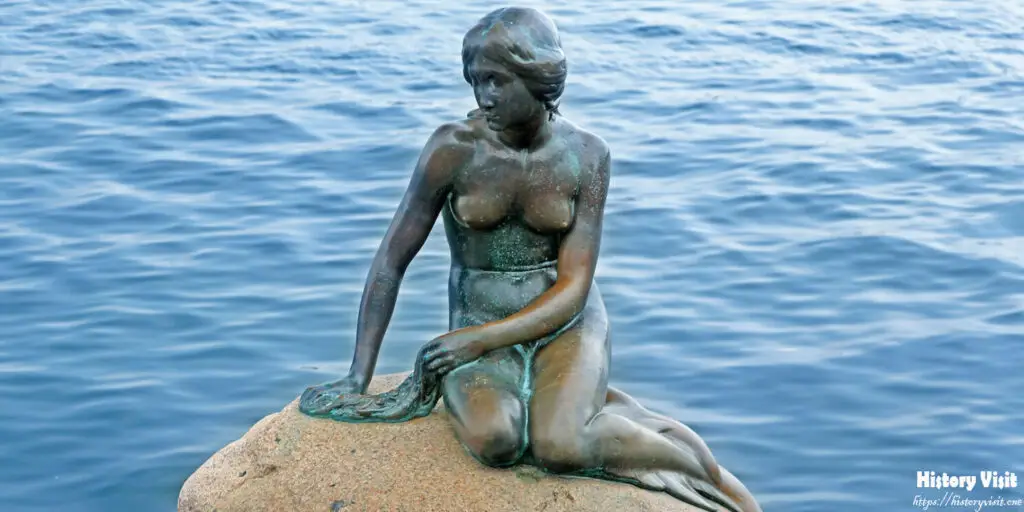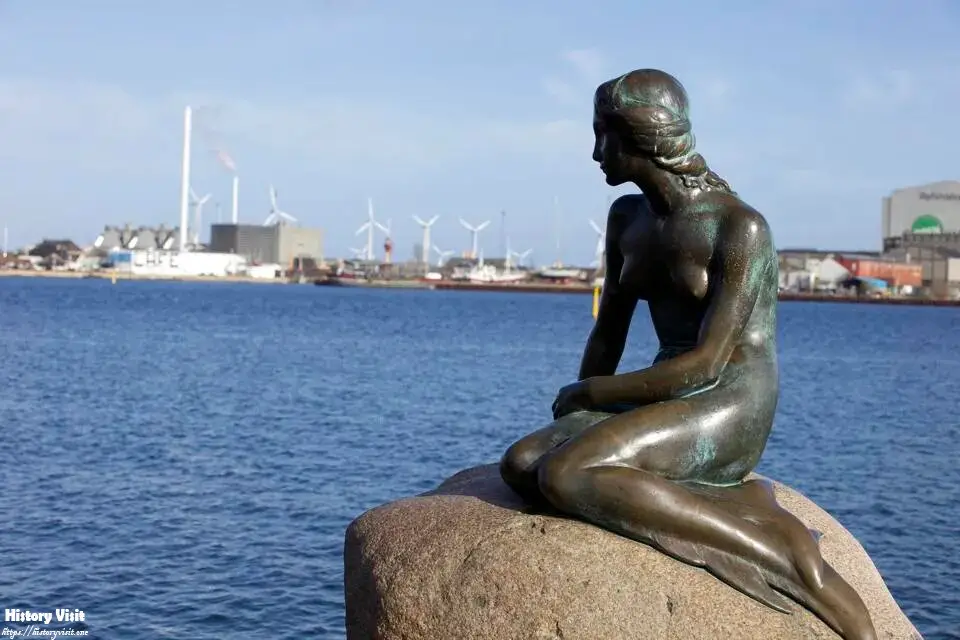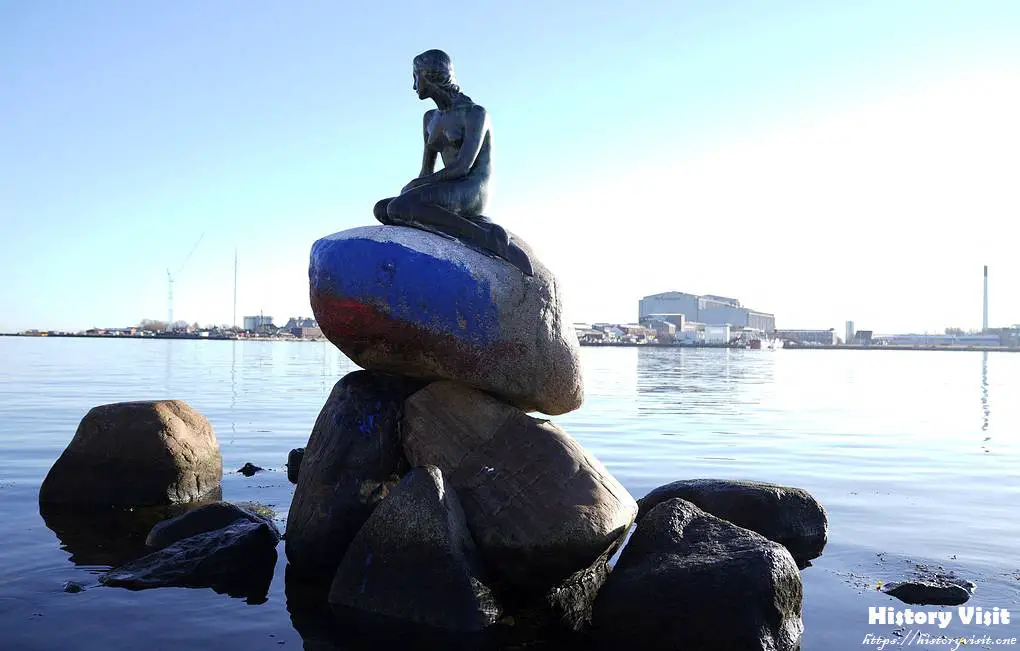Beneath the Waves: The Little Mermaid Sculpture by Edvard Eriksen (1913)

Introduction
Sculptures often serve as silent storytellers, capturing the essence of a narrative or symbolizing cultural motifs. Nestled along the picturesque waterfront of Copenhagen, Denmark, stands one such iconic sculpture: “The Little Mermaid.” Crafted by Danish artist Edvard Eriksen in 1913, this enchanting statue has become a beloved symbol of Copenhagen’s maritime heritage and a testament to the enduring allure of Hans Christian Andersen’s timeless fairy tale.
As one of the most visited landmarks in Denmark, “The Little Mermaid” draws throngs of admirers each year, all eager to catch a glimpse of the graceful figure perched on a rock by the sea. Beyond its role as a tourist attraction, the sculpture holds profound cultural significance, embodying themes of love, sacrifice, and the eternal quest for belonging. In this article, we delve into the origins, symbolism, controversies, and enduring legacy of Edvard Eriksen’s masterwork.
The Artist: Edvard Eriksen

Edvard Eriksen, born in 1876, was a Danish sculptor renowned for his craftsmanship and attention to detail. Trained at the Royal Danish Academy of Fine Arts, Eriksen honed his skills under the tutelage of prominent sculptors, eventually establishing his own studio in Copenhagen. While Eriksen created numerous works throughout his career, it was his rendition of “The Little Mermaid” that catapulted him to international fame.
Inspired by Hans Christian Andersen’s beloved fairy tale, Eriksen embarked on the ambitious task of bringing the mermaid’s ethereal beauty to life in marble. Drawing upon his expertise in classical sculpting techniques, Eriksen meticulously crafted each aspect of the sculpture, from the mermaid’s flowing hair to the intricate scales adorning her tail. His attention to detail and ability to evoke emotion through his artistry earned him accolades from critics and admirers alike.
Despite his success as a sculptor, Eriksen remained modest and unassuming, preferring to let his work speak for itself. He regarded “The Little Mermaid” not as a personal triumph, but rather as a tribute to Andersen’s enduring legacy and the maritime heritage of Denmark. Eriksen’s dedication to his craft and his ability to capture the imagination of viewers cemented his place as one of Denmark’s most celebrated artists.
Creation of the Sculpture

Commissioned by brewer Carl Jacobsen, founder of the Carlsberg brewery, “The Little Mermaid” was conceived as a gift to the city of Copenhagen. Jacobsen, a patron of the arts and a fervent admirer of Andersen’s fairy tales, envisioned the sculpture as a symbol of the city’s maritime heritage and a tribute to one of Denmark’s most beloved authors. He entrusted Eriksen with the task of bringing his vision to fruition, confident in the sculptor’s ability to capture the essence of Andersen’s enchanting tale.
Eriksen began work on the sculpture in 1909, drawing inspiration from Andersen’s poignant narrative and the rugged beauty of Denmark’s coastline. He spent countless hours refining his design, experimenting with various poses and expressions until he achieved the perfect balance of grace and melancholy. Using a combination of marble and bronze, Eriksen painstakingly sculpted each element of the mermaid’s form, infusing the statue with a sense of ethereal beauty and timeless elegance.
The creation of “The Little Mermaid” was not without its challenges. Eriksen faced technical difficulties in translating his vision into tangible form, particularly in capturing the delicate features of the mermaid’s face and the intricate details of her tail. Additionally, he grappled with the inherent limitations of his chosen medium, striving to imbue the sculpture with a sense of movement and fluidity despite the constraints of solid stone. Despite these obstacles, Eriksen persevered, driven by a desire to create a work of art that would resonate with viewers for generations to come.
Symbolism and Interpretation

At first glance, “The Little Mermaid” may appear as a simple depiction of a mythical creature gazing wistfully out to sea. However, upon closer inspection, the sculpture reveals layers of symbolism and meaning, inviting viewers to ponder the deeper themes at play. The mermaid’s posture, with one hand resting on her chin and the other trailing languidly in the water, conveys a sense of contemplation and longing, as if she is lost in reverie.
One of the central themes of Andersen’s fairy tale is the quest for love and acceptance, a theme that is poignantly reflected in Eriksen’s sculpture. The mermaid’s longing gaze towards the horizon speaks to her yearning for a world beyond the confines of the sea, where she might find the love and belonging that eludes her beneath the waves. Her sacrifice, trading her voice for a chance at human love, serves as a poignant reminder of the enduring power of love and the sacrifices we are willing to make in its pursuit.
“The Little Mermaid” also serves as a symbol of Denmark’s maritime heritage and its deep connection to the sea. Perched on a rock at the water’s edge, the mermaid embodies the spirit of adventure and exploration that has long characterized Danish seafaring culture. Her presence along Copenhagen’s waterfront serves as a constant reminder of the city’s rich maritime history and its enduring ties to the sea.
Impact and Legacy

From the moment of its unveiling in 1913, “The Little Mermaid” captivated the imagination of viewers and critics alike, earning praise for its beauty and emotional resonance. The sculpture quickly became one of Copenhagen’s most beloved landmarks, attracting visitors from around the world eager to catch a glimpse of the iconic mermaid. Over the years, “The Little Mermaid” has transcended its status as a mere work of art to become a cultural icon, symbolizing the spirit of Copenhagen and the timeless appeal of Andersen’s fairy tales.
Despite its popularity, “The Little Mermaid” has not been immune to controversy and criticism. Over the years, the sculpture has been subjected to numerous acts of vandalism and theft, prompting calls for increased security measures to protect this cherished symbol of Danish identity. Despite these challenges, “The Little Mermaid” endures as a testament to the enduring power of art to inspire, provoke, and unite people from all walks of life.
Controversies and Conservation Efforts

“The Little Mermaid” may be a symbol of beauty and grace, but it has not been immune to controversy and challenges. Over the years, this iconic sculpture has faced numerous acts of vandalism, theft, and even calls for its removal, sparking debates about its preservation and protection.
Despite its status as a beloved landmark, “The Little Mermaid” has been the target of vandalism on multiple occasions. From having its head and arms sawn off to being doused in paint, the sculpture has endured numerous acts of defacement over the years. These acts of vandalism have not only defiled a cherished symbol of Danish identity but have also raised concerns about the security and protection of public artworks.
In response to these challenges, authorities have implemented various conservation efforts to safeguard the sculpture and preserve its integrity. Enhanced security measures, including surveillance cameras and regular patrols, have been put in place to deter would-be vandals and protect the sculpture from harm. Additionally, conservation experts regularly monitor the condition of the sculpture, conducting routine inspections and maintenance to ensure its long-term preservation.
Despite these conservation efforts, “The Little Mermaid” remains a target for controversy and debate. In recent years, calls for the sculpture’s removal have emerged, with some arguing that its presence perpetuates outdated stereotypes and fails to adequately represent the diversity of Copenhagen’s population. Proponents of removal suggest relocating the sculpture to a museum where it can be contextualized and interpreted within a broader cultural framework.
However, such proposals have been met with resistance from those who view “The Little Mermaid” as an integral part of Copenhagen’s cultural heritage. Advocates for the sculpture’s preservation argue that its removal would erase an important symbol of Danish identity and diminish the city’s appeal to tourists and visitors. Instead, they call for greater investment in education and outreach initiatives to promote a deeper understanding of the sculpture’s historical and cultural significance.
Conclusion

“The Little Mermaid” stands as more than just a sculpture; it’s a testament to the enduring power of art to captivate hearts and minds across generations. Despite the controversies and challenges it has faced over the years, this iconic symbol of Copenhagen’s maritime heritage continues to enchant visitors from around the world with its timeless beauty and poignant symbolism.
As it gazes out to sea, “The Little Mermaid” serves as a reminder of the universal themes of love, sacrifice, and the eternal quest for belonging that resonate with people of all ages and cultures. Its enduring legacy speaks to the profound impact of Hans Christian Andersen’s fairy tales and the artistic vision of Edvard Eriksen, who brought the mermaid’s ethereal beauty to life in marble and bronze.
While controversies and debates surrounding its preservation and interpretation may persist, “The Little Mermaid” remains an integral part of Copenhagen’s cultural landscape, a cherished symbol of Danish identity, and a source of inspiration for generations to come. As we continue to navigate the complexities of art, culture, and heritage in the modern world, “The Little Mermaid” serves as a timeless reminder of the power of imagination, storytelling, and the enduring legacy of those who dare to dream beneath the waves.


